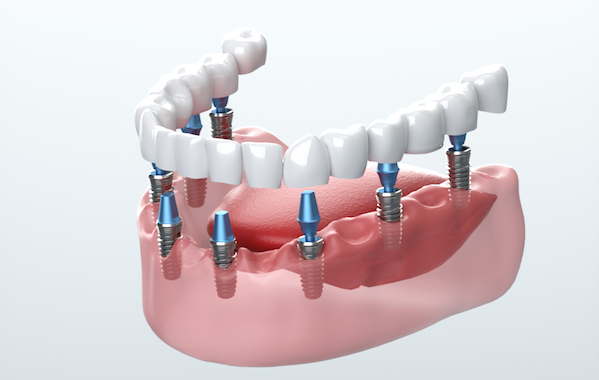Getting The Dental Implants To Work
Getting The Dental Implants To Work
Blog Article
An Unbiased View of Dental Implants
Table of Contents9 Simple Techniques For Dental Implants6 Easy Facts About Dental Implants ExplainedThe 2-Minute Rule for Dental ImplantsThe 3-Minute Rule for Dental Implants
are clinical devices surgically dental implanted right into the jaw to restore a person's capability to eat or their appearance. They supply assistance for artificial (fake) teeth, such as crowns, bridges, or dentures. When a tooth is shed as a result of injury or disease, a person can experience issues such as quick bone loss, malfunctioning speech, or changes to chewing patterns that lead to pain.
Structure of The Oral Implant System selecting dental implants, speak with your dental service provider about the possible benefits and threats, and whether you are a candidate for the procedure. Points to take into consideration: Your general health and wellness is an essential consider establishing whether you are a great candidate for oral implants, how much time it will take to heal, and how much time the dental implant might remain in area.
Smoking cigarettes may influence the healing process and lower the long-lasting success of the dental implant. The healing process for the implant body may take numerous months or longer, throughout which time you normally have a short-lived joint instead of the tooth. the dental implant treatment: Carefully comply with the oral hygiene guidelines offered to you by your dental service provider.
Getting My Dental Implants To Work
Implant failure can result in the requirement for an additional procedure to repair or change the dental implant system. Recovers the capacity to eat Restores cosmetic appearance Helps keep the jawbone from diminishing due to bone loss Protects the wellness of the bordering bone and periodontals Aids maintain nearby (close-by) teeth secure Enhances high quality of life Damage to surrounding natural teeth during dental implant positioning Injury to the surrounding cells throughout surgery, such as sinus opening Injury throughout surgical procedure (for instance, fracture of bordering jawbone) Inadequate function, such as seeming like the teeth do not bite together generally A sensation that the tooth is loosened or twisting in position arising from a joint screw loosening up Implant body failing (looseness of the implant body) because of systemic infection, which might be a lot more most likely in people with unrestrained diabetes mellitus as a result of local infection these details in bone and gum tissues supporting the implant body as a result of postponed healing, which may be most likely in people that smoke Difficulty cleansing the periodontals around the implant, leading to poor dental hygiene Neglected gum illness Post-surgical pins and needles due to nerve impingement or damages Always inform healthcare service providers and imaging technicians that you have oral implants before any kind of magnetic vibration imaging (MRI) or x-ray procedures.
FDA is not familiar with any kind of adverse occasions reported for MRI or x-ray treatments with dental implants. Dental implants systems are generally made of products that adhere to global consensus requirements of the International Company for Standardization (ISO) or ASTM International. These requirements have information of what makes a safe product.
Dental implant systems are reviewed according to global agreement criteria. Biocompatibility testing, to reveal that physical contact with the device does not create complications like inflammation or sensitive response, is component of the evaluation that helps guarantee the materials in the dental implant system are safe and do not cause adverse effects when implanted in individuals.

Not known Details About Dental Implants
Some people are not qualified for dental implant surgical procedure. It is for oral cosmetic surgeons to operate individuals with: severe illnessuncontrollable metabolic diseasebone or soft tissue disease or infectionIf these problems are resolved, a person can have the surgical treatment. Dental Implants. In, dental specialists avoid operating on individuals with: If individuals with any of the above go through oral implant surgical procedure, there is a greater risk of the implant falling short
Some people have a jawbone abnormality that stops enough bone for a dental implant from establishing. In such instances, a surgeon might require to do a ridge adjustment. This involves lifting the periodontal to expose the area of deformed bone. The doctor will then utilize a bone or bone replacement to fix and accumulate the area.
Oral dental implant surgical procedure is an individualized process. Provide you time to heal. Affix the blog post and final crown, bridge or denture.
Next, your cosmetic surgeon will carefully put the dental implant into your jaw. If your implant is near the front of your mouth, your dental practitioner will make a short-lived tooth for you to use till you heal.
The Main Principles Of Dental Implants
Your copyright can inform you what to expect in your circumstance. Throughout the healing phase, your jawbone must fuse to the oral implant. This process, called osseointegration, is vital for security and long-term success. This procedure can take anywhere from 3 to 9 months. In some instances, it might take longer.
Once your dental implant heals, your dental expert can attach the joint (little connector post) and your last remediation (crown, bridge or denture). This typically my explanation takes about one hour to finish and may call for a 2nd minor surgical procedure. You should not feel any discomfort during your oral implant procedure because your company will make use of medicine to numb your gums.
Report this page